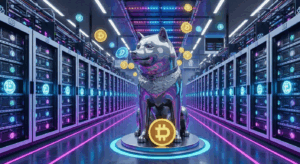The Aave protocol is one of the most innovative and established solutions within the Decentralized Finance (DeFi) ecosystem. With an efficient architecture and a unique governance model, it allows users to lend and borrow resources without intermediaries, bringing security and transparency to the crypto market.

How Does the Aave Protocol Work?
Aave operates based on decentralized liquidity pools, where users who want to lend digital assets deposit their cryptoassets into smart contracts called pools. In return, these providers receive tokens called aTokens, which represent their deposit and automatically accumulate interest, reflecting the earnings generated by the pool.
For those who want to take out loans, the protocol requires an overcollateralization model, meaning the value locked as collateral must be greater than the loan amount. Each asset has a maximum loan rate called Loan-to-Value (LTV), which determines the limit for borrowers. Additionally, the position’s health is monitored by the Health Factor, which indicates whether the collateral keeps the loan secure. If this factor drops below 1, liquidations may occur to protect the protocol.
The flexibility of Aave stands out in its interest rate options, allowing users to choose between a variable rate — which adjusts according to pool demand — and a stable rate, ideal for planning costs over defined terms. This feature offers greater control and financial sophistication to users.
Decentralized Governance by Aave DAO
Unlike traditional financial systems, the Aave protocol is not managed by a centralized company. Its governance is exercised by the Aave DAO — a decentralized autonomous organization composed of AAVE token holders. These holders vote on Improvement Proposals (AIPs) that determine the protocol’s direction, including risk parameters, updates, and new features.
Aave’s differential is the V3 governance architecture, which separates the stages and networks to make the process more efficient: the main network on Ethereum maintains security, blockchains like Polygon are used for voting with reduced costs, and executions happen on the networks where the protocol operates. Moreover, the model allows vote delegation, increasing participation and creating a representative system within the DAO.
Although decentralized, Aave recognizes the need for technical expertise for maintenance and innovation. Therefore, it funds specialized teams — such as Aave Labs — to develop essential features, respecting the community’s final control.
Security and Resilience in the Aave Ecosystem
Security is one of Aave’s fundamental pillars, adopting a multifaceted approach to protect its users and assets. The protocol undergoes rigorous security audits conducted by renowned firms, ensuring the smart contracts are protected against known vulnerabilities.
Additionally, the platform maintains bug bounty programs, encouraging white-hats to responsibly identify flaws. To reinforce economic robustness, Aave operates a security module where AAVE token holders stake to protect against potential deficits in the protocol; in return, they receive rewards.
Among security innovations, Flash Loans stand out — instant and uncollateralized loans that must be repaid within the same blockchain transaction. This functionality, although powerful for arbitrage and liquidations, also requires caution due to its potential use for exploits in other protocols.
Another relevant point is user interface security, an essential part of preventing common attacks such as phishing. Aave Labs implements advanced protections in its official web application but recommends users always verify the correct address and exercise caution when connecting wallets.
Still, challenges related to full decentralization persist, mainly in the concentration of voting power among large holders and the need for centralized teams for critical operations. The protocol thus stands as a mature example of decentralized governance balanced with efficiency and security.
To learn more about other innovative protocols in this area, also check out our PancakeSwap analysis, which complements understanding about liquidity in DeFi.
Want to better guide yourself in financial strategies within cryptocurrencies? Our article on SEO content optimization can help expand your strategic vision.
Finally, when following the impact of stablecoins on the decentralized market, we recommend reading about news involving stablecoins and their importance to the DeFi ecosystem.









